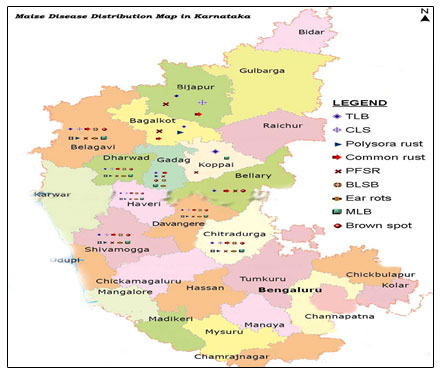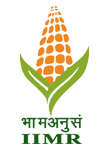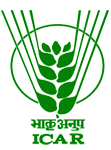Name of the centre : DHARWAD
Latitude 15° 26’ North and 75° 07’ East with a mean altitude of 678 m MSL.
Address : AICRP on Maize, Research Complex, University of Agricultural Sciences, Dharwad, 580005 Karnataka state
Staff details:
| Sl No | Name | Designation | Working w.e.f |
| 1 | Dr. S.I.Harlapur | Principal Scientist (Plant Pathology) and In-Charge | 14.05.2015 |
| 2 | Dr.S.R.Salakinkop | Associate Professor (Agronomy) | 01.07.2017 |
| 3 | Dr. R.M.Kachapur | Scientist (Plant Breeding) | 14.05.2015 |
| 4 | Dr. G.K.Naidu | Assistant Maize Breeder | 04.07.2019 |
| 5 | Vacant | Sr. Technical Assistant | Vacant, Post to be filled |
| 6 | Vacant | Sr. Technical Assistant | Vacant, Post to be filled |
| 7 | Shri S.B. Hugar | Field Assistant | 05.10.2018 |
| 8 | Shri A.G.Patil | Field Assistant | 01.04.2018 |
| 9 | Vacant | Field Assistant | Vacant, Post to be filled |
| 10 | Vacant | LDC/Sr. Typist (Assistant) | Vacant, Post to be filled |
Mandate:
- Development of medium and long duration hybrids suitable for rainfed and irrigated ecologies of Kharif and Rabi season
- Development of early and medium duration single cross hybrids for the rainfed ecosystem in southern Karnataka.
- Disease screening of early, medium and long duration hybrids and specialty corn hybrids against Turcicum leaf blight, Common rust and Charcoal stalk rot diseases.
- Survey and surveillance, Epidemiology and management of Turcicum leaf blight, Common rust and Charcoal stalk rot diseases.
- Agronomic investigations of Kharif and Rabi Maize for rainfed and irrigated ecologies.
Farm area: 22 Acres
Significant achievements:
- In 1955, a three way hybrid S-23 (I-5 × L-5) was developed and released by this centre which recorded 30 per cent higher yield than Arabhavi local with two per cent higher protein.
- During 1957, the center was upgraded to AICRP (Maize) centre. Further, the centre contributed for the release of Deccan, Ganga-1, Ganga-101 hybrids and Ranjit composite by the project in 1961.
- From 1968 to 1987, the centre collaborated in release of maize hybrids like Deccan-101(1975), Deccan-103 (1982) and Deccan-105 which were recommended for Karnataka.
- An early maize composite G-25 (Renuka) which matures in 85 to 90 days and was found suitable for growing with 170 CO-2 cotton, which became popular in mixed cropping system of this region was released in 1984.
- During 1989, another full season composite G-57 (Prabha) was developed which was on par with the yield of Deccan-103 with tolerance to borer infestation, Turcicum leaf blight, downy mildew, Erwinia stalk rot and late wilt.
- The double top cross hybrid DMH-1 with 15% per cent higher yield compared to Deccan-103 and Prabha was developed and released during 1996.
- The first ever single cross hybrid DMH-2 (CI-4 × KDMI-10) was developed and released for Karnataka during 2002.
- During 2009, a modified single cross hybrid EH- 434042 (Arjun) with multiple disease tolerance was developed and released for Northern parts of Karnataka.
- In the year 2012, a single cross hybrid GH-0727 (Shrushti) has been released for Karnataka state.
- Intercropping of maize in cotton or newly planted sugarcane with early maturing maize genotypes is a remunerative cropping systems for the small and marginal farmers.
- Intercropping of two rows of soybean in between 90 cm rows of maize is found profitable and farmer could get additional profit over sole maize.
- The planting geometry of 60×20 cm recorded higher grain yield than either 75×20 cm or 60×30 cm. Maize responded up to 150% of RDF without the application of FYM.
- Application of 150:65:65 kg N:P2O5:K2O per ha with nitrogen in 5 splits @ 10% at basal, 30% each at 4 and 8 leaf stage, 20% at tassel emergence / flowering stage and remaining 10% N at early grain filling stage recorded higher grain yield than recommended practice of N application in 3 splits (33% each at basal, 30 and 45 DAS).
- Sequential application of pendemethalin (1000 mlha-1) as pre-emergence followed by Atrazine (750 g a.i. /ha) + 2,4-D Amine 0.4 kg a.i./ha at 25 DAS as Post emergent recorded significantly lower weed counts and higher grain yield.
- For management of TLB spraying of Mancozeb @ of 2.5 grams/lit. of water after initiation of the disease should be done at knee-high stage. Second and third spray to be done at intervals of 10 days, if necessary.
- Spraying of propiconozole 25% EC (Tilt) @ 1 ml/lit. of water at 30 and 45 days after sowing proved most effective in controlling rust.
- Application of Pseudomonas fluorescens @ 0.5% as seed treatment with bioagent-fortified FYM (1:50) and spray @ 0.5% found effective in suppressing the PFSR.
- Foliar application of Tebuconazole 250EC @ 0.1% showed combined resistance to TLB and Common Rust diseases and resulted in 38.16% increase in yield over untreated control.
- Single cross hybrid GPMH-1101 has been identified for release for Zone 3 (Northern dry zone) of Karnataka state. Notification awaited.
- Two genetic stocks, DHKN 509 and DHKN 563 with high kernel rows have been submitted for registration with PPV-FRA
- Single cross hybrid GH-0727 (Shrusti) has been registered with PPV-FRA.
- Foliar Application of combi product fungicides namely, Trifloxystrobin 25% + Tebuconazole 50% (Nativo) @ 0.1%, Azoxystrobin 18.23% + Difenoconazole 11.4% (Amistar Top) @ 0.1% found significantly superior with respect to TLB and common rust diseases control and resulted in 35 to 41% increase in grain yield over unprotected check.
- Pseudomonas fluorescens @ 0.5% as seed treatment, biogent-fortified FYM (1:50) and spray @ 0.5% found effective in suppressing the PFSR which recorded 47.66% disease control efficacy and resulted in 21.32% increase in grain yield over untreated check.
- IDM module comprised of seed treatment with Trichoderma harzianum @ 10g/kg seed + Thiram 75WP @ 2g/kg seed, foliar application of Nimbicidine @ 5ml/litre @ 35 DAS, followed by Azoxystrobin 18.2% + Difenoconazole 11.4% (Amistar Top) @ 1ml/litre of water at 35-40 days after sowing found ideal IDM strategy for TLB management which resulted in 27.12% increase in grain yield over unprotected check.
- Two CIMMYT lines viz., VL 176109 and VL 176270 registered resistant reaction to TLB.
- Application of Atrazine @ 1.5 kg/ha pre-emegence followed by Tembotrione (Laudis) 120 g a.i./ha PoE at 25 DAS recorded significantly lesser weeds population and higher maize grain yield.
- Ecological intensification treatment resulted significantly higher grain yield and net returns compared to farmers’ practice.

Hybrids released from the centre



Management of Turcicum leaf blight of Maize

Untreated control
Azoxystrobin 18.23% + Difenconazole 11.4%
(Amister Top) @ 0.1%

